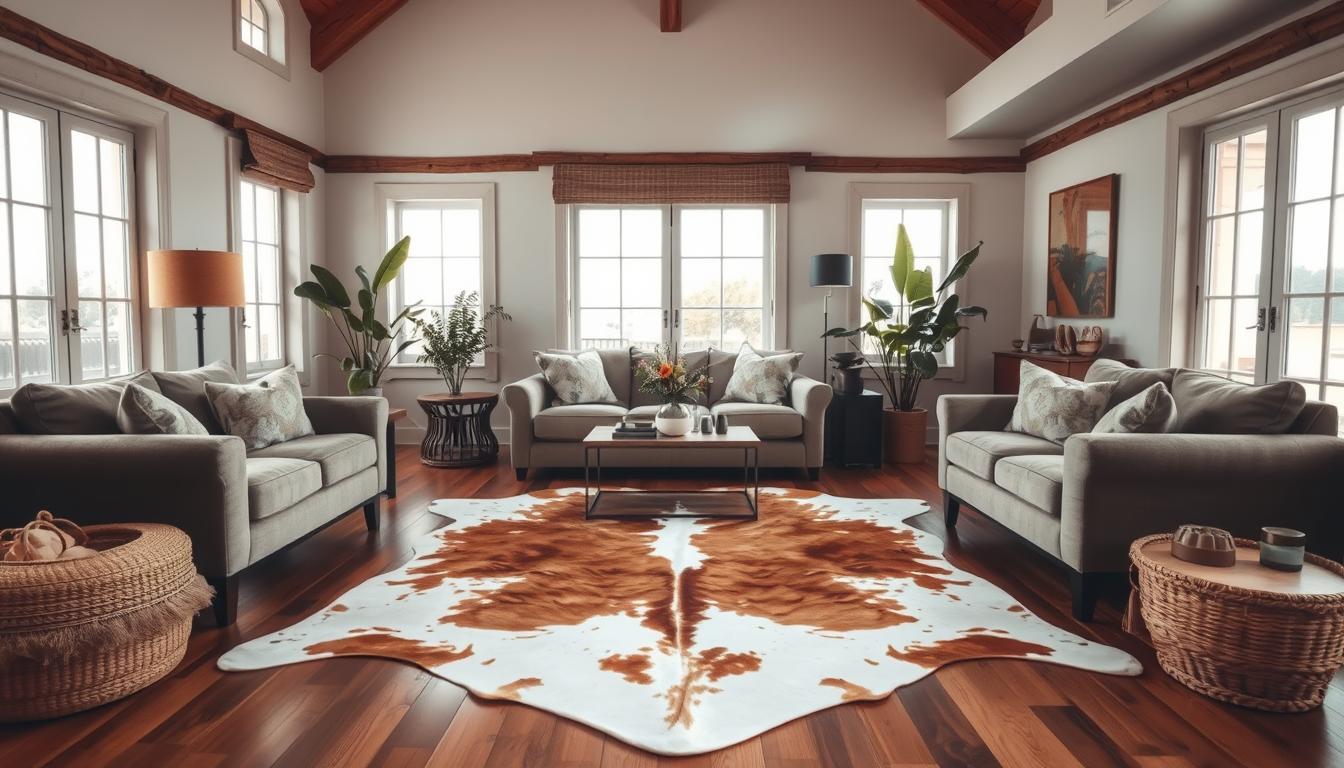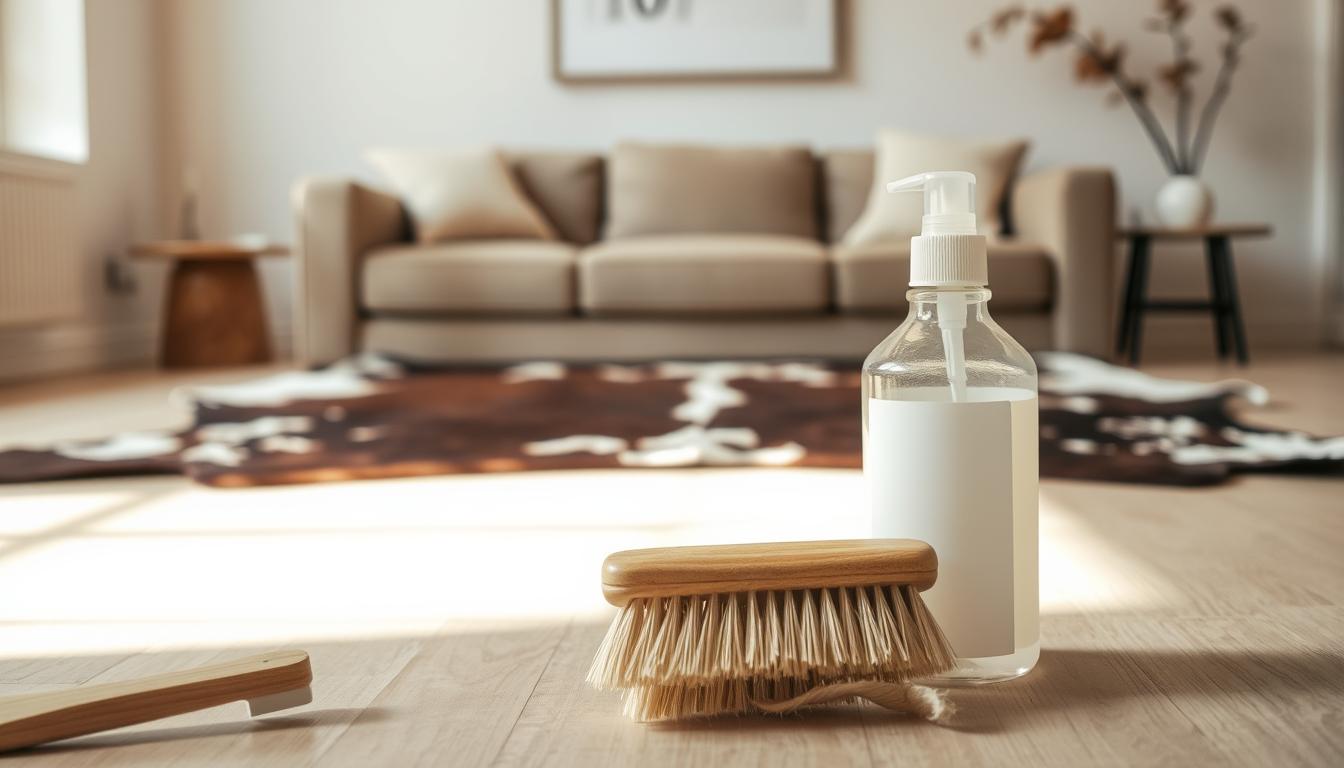
5 Chic Living Room Ideas with a Cowhide Rug

What if one design element could instantly elevate your home’s style while standing the test of time? Cowhide rugs aren’t just a trend – they’re a timeless investment that bridges bold aesthetics with practical durability. Each piece tells a story through its natural patterns, ensuring your décor feels curated, not cookie-cutter.
For over 25 years, a family-run business has perfected the art of selecting only the top 10-15% of hides. These A-grade rugs feature 100% real leather with suede backing, certified for authenticity and crafted using ISO 9001 processes. They’ve graced homes across 71 countries, proving their adaptability to spaces ranging from sleek modern lofts to cozy farmhouse settings.
Worried about shedding or curling? These rugs defy wear and tear, thriving even in high-traffic zones. Their organic variations mean no two designs match – your space gets a signature focal point. Ready to explore how they transform interiors? Discover five fresh styling approaches in our in-depth guide on selecting premium cowhide.
Key Takeaways
- Elevate your décor instantly with natural, one-of-a-kind patterns
- Enjoy guaranteed durability against shedding or curling
- Verify authenticity through included certificates
- Choose from globally trusted designs used in 71+ countries
- Adapt effortlessly to any style, from minimalist to rustic
Understanding the Appeal of a Cowhide Rug in Your Living Room
The magic of interior design lies in pieces that command attention while blending seamlessly with your existing decor. These natural floor coverings achieve this balance effortlessly, offering organic artistry that synthetic materials can't match. Their irregular edges and unpredictable markings create instant depth, turning flat surfaces into dimensional canvases.
Unique Textures and Natural Patterns
Run your fingers across a genuine hide, and you'll feel why texture matters. Unlike flat-woven alternatives, these rugs combine silky smooth areas with rugged natural imperfections. This tactile variety breaks visual monotony, especially when paired with sleek furniture or polished floors.
No two pieces share identical markings – each hide’s spots, swirls, and color transitions form a one-of-a-kind masterpiece. As designer Mara Santos notes:
"A cowhide's pattern tells an unrepeatable story, making it the ultimate organic focal point."
Elevating Your Home's Aesthetic
From earthy neutrals to vibrant dyed options, these rugs adapt to any palette. A black-and-white hide sharpens modern spaces, while caramel tones warm minimalist schemes. Their organic shapes soften angular layouts, creating harmony between architectural elements and soft furnishings.
Strategic placement transforms them into style anchors. Drape one beneath a glass coffee table to add warmth, or layer it over neutral carpeting for dimensional contrast. The result? A space that feels curated yet inviting – exactly what discerning homeowners crave.
Choosing the Perfect Cowhide Rug for Your Space
Selecting the right floor accent requires balancing proportions with personality. Start by mapping your layout – measure wall-to-wall distances and note furniture clusters. This ensures your choice enhances flow rather than disrupting it.
Size and Placement Considerations
Follow the golden ratio: front legs of seating should rest on the rug. For conversation areas, aim for a 7'x8' hide – large enough to unify pieces without dominating. Irregular shapes naturally soften sharp angles in modern layouts.
Measure from the hide’s widest and tallest points. Oversized options work under dining tables, while compact sizes suit entryways. Pro tip: Use painter’s tape to outline potential placements before buying.
Authentic Versus Faux Options
Genuine hides offer nature’s artistry – no two markings repeat. They’re naturally stain-resistant and improve with age. Synthetic versions provide uniform patterns and bold colors like neon pink, ideal for rental spaces.
| Feature | Real Cowhide | Faux Cowhide |
|---|---|---|
| Pattern Uniqueness | 100% one-of-a-kind | Repeating designs |
| Maintenance | Spot clean only | Machine washable |
| Eco-Friendliness | Biodegradable | Plastic-based |
White cowhide rugs serve as neutral canvases – layer them with jewel-toned throws for contrast. For detailed comparisons between materials, explore our comprehensive buying guide.
Styling a living room with cowhide rug for Maximum Impact
Center your design around a natural masterpiece that commands attention. A strategically placed hide becomes more than flooring – it’s the gravitational pull that organizes your entire seating area.
Creating a Central Focal Point
Position your rug to anchor key pieces like sofas and armchairs. Front legs of furniture should rest on the edges, creating visual cohesion. This technique works particularly well with coffee tables, transforming them into style statements.
Choose bold patterns to contrast minimalist furniture, or neutral tones to complement vibrant walls. The irregular shape breaks rigid lines, adding organic movement to structured layouts. Design expert Lena Torres observes:
"A centered cowhide rug acts like a compass – every element orbits around its energy."
Three rules for success:
- Scale matters: Ensure the hide spans at least 60% of your seating group
- Layer textures: Pair sleek metal tables with the rug’s natural roughness
- Define zones: Use contrasting colors to separate functional areas
Your coffee table becomes a curated display space when framed by the hide’s unique markings. This approach elevates both small apartments and sprawling lofts, proving versatility meets impact.
Expert Tips for Arranging Furniture Around a Cowhide Rug
How do interior designers create those perfectly balanced spaces? It starts with strategic placement that harmonizes form and function. When working with natural statement pieces, thoughtful arrangement becomes essential.

Establishing Visual Balance
Anchor your seating group by positioning at least two furniture legs on the hide. This creates cohesion between pieces while letting the rug’s organic form soften angular lines. For open layouts, center the hide under your coffee table to define the zone.
Three rules designers swear by:
- Follow the 18-inch rule: Leave breathing room between rug edges and walls
- Mix scales: Pair compact chairs with oversized hides for drama
- Embrace asymmetry: Let the hide’s irregular edges guide furniture angles
Coordinating with Surrounding Decor
Metal and glass surfaces gain warmth when paired with textured hides. In minimalist spaces, choose natural tones that echo wood grains or stone accents. For bold interiors, try dyed options that pick up wall colors.
Interior stylist Lena Torres recommends:
"Treat your cowhide like artwork – position it where light enhances its patterns, then build your palette around its dominant hues."
High-traffic zones benefit most from this durable material. Place it where feet naturally land – beneath coffee tables or beside beds – to showcase both style and practicality.
Layering Techniques with Cowhide Rugs and Other Textiles
Transform flat surfaces into dimensional design statements through strategic textile combinations. Layering floor coverings adds tactile richness while solving practical challenges – think warmth underfoot and sound absorption. The key lies in balancing contrasting textures without overwhelming the eye.
Mixing Patterns and Materials
Start with a neutral foundation. Jute or sisal base rugs provide earthy texture while letting your cowhide take center stage. For contemporary spaces, try pairing geometric-patterned carpets with organic-shaped hides. This creates visual tension that feels intentional yet effortless.
Designer Eli Martinez recommends:
"Treat layered rugs like a conversation – let each material contribute distinct notes while maintaining harmony."
| Base Material | Texture Profile | Style Pairing |
|---|---|---|
| Jute | Coarse, natural | Bohemian & coastal |
| Wool | Plush, dense | Traditional & modern |
| Sisal | Subtle grain | Minimalist & rustic |
| Hides | Silky & rugged | Eclectic & industrial |
Dyed options work wonders over patterned bases – a charcoal hide atop tribal prints creates depth. Rotate pieces seasonally for fresh perspectives without major redecorating. The goal? A collected look that evolves with your style.
Highlighting Architectural Features with Cowhide Accents
Architectural details deserve a spotlight, not an afterthought. Natural floor coverings become strategic tools for emphasizing your space’s inherent character. Their organic forms create visual dialogues with structural elements, turning cold corners into curated moments.

Enhancing Fireplace and Window Displays
Frame your hearth with nature’s artistry. Positioning a hide rug in front of stone or brick fireplaces softens angular lines while adding warmth underfoot. The irregular edges contrast rigid mantels, creating balance between human craftsmanship and wild beauty.
Sunlit areas gain depth when anchored with textured rugs. Place one beneath bay windows to define reading nooks or breakfast corners. Daylight enhances hide patterns, making colors shift subtly throughout the day – a dynamic partnership between nature and design.
| Architectural Feature | Rug Placement | Visual Effect |
|---|---|---|
| Fireplace | 6-12" from hearth base | Softens vertical lines |
| Floor-to-Ceiling Windows | Centered under seating group | Frames exterior views |
| Exposed Beams | Aligned with ceiling direction | Echoes organic textures |
| Stone Accent Walls | Diagonally positioned | Creates movement |
Designer Claire Vero suggests:
"Treat architectural elements as collaborators – let your rug’s shape respond to their angles like dance partners."
For spaces with multiple focal points, layer smaller hides near secondary features. This technique guides the eye without overwhelming. Discover more spatial tricks in our designer-curated styling guide.
Natural light plays beautifully with hide textures. Morning sun emphasizes sleek leather surfaces, while evening lamps cast dramatic shadows across rugged edges. This daily transformation keeps interiors feeling fresh and alive.
Defining Zones in Open-Plan Spaces
Open floor plans offer freedom but often lack visual structure. Natural floor accents solve this elegantly, carving purposeful areas while maintaining airy sophistication. Their organic shapes act as subtle dividers, guiding movement without blocking sightlines.
Creating Distinct Areas Without Walls
Position your statement piece beneath seating clusters to signal dedicated conversation zones. Front legs of sofas and chairs resting on the hide’s edges create cohesion. This technique separates lounging spaces from dining nooks or kitchen pathways effortlessly.
For modern apartments, center the accent under coffee tables. Arrange seating in a U-shape around it to maximize flow. The hide’s irregular outline softens rigid layouts, making multi-use spaces feel intentional. Pro tip: Use contrasting colors to differentiate zones – charcoal hides pop against light floors.
Strategic placement near architectural features enhances functionality. Flank your rug with tall plants or floor lamps to reinforce boundaries. This approach maintains openness while adding layered depth – perfect for urban dwellers mastering the art of flexible design.
FAQ
How do cowhide rugs enhance a home’s aesthetic?
Their natural patterns and unique textures add depth and organic charm. These rugs effortlessly blend with modern, rustic, or eclectic styles, creating visual interest while anchoring furniture arrangements.
What size works best for open-plan spaces?
Opt for larger sizes like 8’x10’ to define zones. Layer smaller tricolor or brindle cowhide rugs over neutral carpets to create distinct areas without disrupting the flow of your layout.
Can faux cowhide rugs mimic authentic ones?
High-quality synthetic options replicate the look and feel of real hides. They’re ideal for high-traffic areas or households with pets, offering durability and easy maintenance.
How do you mix cowhide patterns with other textiles?
Pair neutral-colored hides with geometric or floral pillows. Use metallic accents or beige cowhide rugs to balance bold prints, ensuring textures complement rather than clash.
What’s the best way to highlight a fireplace with cowhide?
Drape a black-and-white cowhide rug nearby or layer a chocolate-colored hide under a coffee table. Add brindle pillows to draw attention to the fireplace as a focal point.
Are dyed cowhide rugs suitable for light-colored rooms?
Yes! Pastel-dyed or grey cowhide rugs add subtle contrast without overwhelming soft palettes. Pair them with light wood furniture and metallic decor for a cohesive look.
How do you maintain cowhide rugs in high-traffic areas?
Shake them outdoors monthly and spot-clean spills promptly. Rotate placement every few months to ensure even wear, especially with brown or white cowhide options.
Can cowhide rugs work in minimalist designs?
Absolutely. A single black cowhide rug under a sleek coffee table adds warmth without clutter. Pair it with monochrome pillows and clean-lined furniture for balance.









